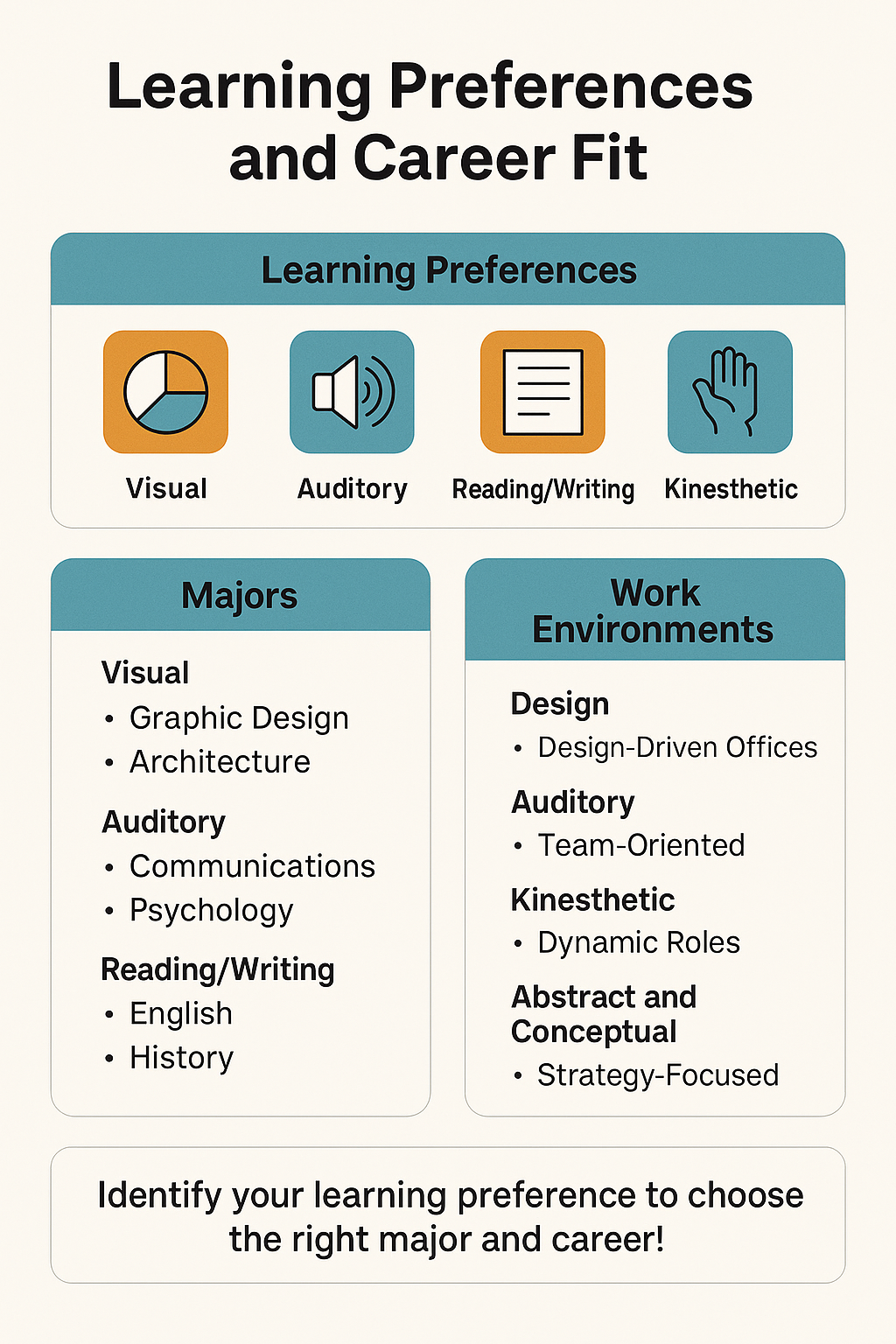Have you ever wondered why some students excel in lecture-heavy majors while others thrive in hands-on workshops or group projects? The truth is, it’s not just about intelligence or motivation – your learning preferences play a crucial role in both academic success and long-term career satisfaction.
By understanding how you learn best, you can choose a major that energizes you, pick courses that align with your strengths, and ultimately find a career environment where you can truly flourish. In this guide, we’ll explore how learning preferences connect to career fit, provide practical steps to identify your style, and share tips for students and career changers alike.
What are learning preferences?
Learning preferences, sometimes called learning styles or cognitive styles, refer to the ways in which individuals prefer to absorb, process, and retain new information.
Popular frameworks and styles
- VARK model (Fleming & Mills, 1992)
- Visual learners prefer diagrams, charts, and spatial representations.
- Auditory learners thrive on lectures, discussions, and verbal explanations.
- Reading/Writing learners excel through text-based input and note-taking.
- Kinesthetic learners learn best through hands-on activities and real-world experiences.
- Multiple intelligences (Gardner, 1983)
- Highlights different types of “intelligences” like logical-mathematical, interpersonal, intrapersonal, linguistic, and more.
- Kolb’s experiential learning theory (Kolb, 1984)
- Emphasizes learning as a process through concrete experience, reflective observation, abstract conceptualization, and active experimentation.

Why does this matter?
These frameworks help you understand not only how you learn best but also how you interact with work tasks and professional environments.
Key takeaway: Recognizing your learning style is the first step toward selecting the right major and designing a meaningful career path. The second step is to take a career strengths test to discover your career matches.
How learning preferences influence major selection
Your learning preference can strongly shape which academic fields resonate with you and which feel frustrating or disengaging.
Examples of learning preferences and major fit
- Visual learners
- Enjoy majors like graphic design, architecture, engineering, and data visualization.
- Benefit from diagrams, flowcharts, and spatial models.
- Kinesthetic learners
- Thrive in fields like nursing, performing arts, sports science, and engineering labs.
- Prefer hands-on projects, internships, and lab-based coursework.
- Auditory learners
- Excel in majors such as communications, education, psychology, and languages.
- Benefit from seminars, discussions, and oral presentations.
- Reading/Writing learners
- Enjoy English literature, law, history, philosophy, and other text-heavy disciplines.
- Prefer essays, research papers, and extensive reading assignments.
Why mismatches happen
Students often choose majors based on external factors – prestige, family expectations, or perceived job security, rather than their own cognitive styles.
Research shows that students who select majors aligned with their learning preferences report higher academic satisfaction and are less likely to change majors.
Connecting learning preferences to work environments
After graduation, your learning style continues to influence where you feel most energized and successful.
Work environment examples
- Kinesthetic learners often prefer dynamic roles involving movement and real-world interaction, such as fieldwork, clinical environments, or creative studios.
- Visual learners may excel in design-driven offices or tech workplaces where data visualization and visual problem-solving are central.
- Auditory learners might thrive in team-oriented, discussion-based environments like sales, counseling, or management.
- Abstract and conceptual learners enjoy strategy-focused or research-heavy roles that involve theory and big-picture thinking.
Task structure and workflow preferences
- Structured vs. flexible schedules
- Independent vs. collaborative projects
- Predictable tasks vs. dynamic problem-solving
Understanding this connection helps you seek internships, part-time jobs, or entry-level roles that reinforce rather than drain your energy.
Tip: When exploring internships or new positions, ask about typical daily activities and learning opportunities to ensure alignment with your style.
How to identify your learning style?
While you might have an intuitive sense of your preferences, it’s often helpful to confirm them through structured reflection or assessments.
Practical ways to identify your style
1. Take an assessment
To identify your strengths and traits, try taking strengths-based assessments like the HIGH5 Test.
2. Reflect on past experiences
Ask yourself some self-reflecting questions like: “Which classes or projects did you find most engaging?” and “What study methods helped you remember information easily?”.
3. Observe your default behavior in group settings
Ask yourself: “Do you like drawing diagrams on a whiteboard?” and “Do you prefer listening to instructions or jumping straight into action?”.
4. Seek input from academic advisors and mentors
Advisors often notice learning preferences even if students don’t explicitly articulate them.
Action steps for students and career changers
Now that you understand how learning preferences and strengths influence your major and career choices, it’s time to put this insight into action.
1. Reevaluate your current or prospective major
- Audit your coursework: Which classes do you naturally gravitate toward? Which feels draining?
- Align electives and specialization tracks with your learning style.
- Discuss alternative majors or minors with your academic advisor.
2. Explore experiential learning opportunities
- Internships, co-ops, research assistantships, and volunteer roles can provide a “test drive” for future work environments (read more about internship matching).
- Seek opportunities that match your learning style:
- Kinesthetic learners → hands-on labs, field studies, internships.
- Visual learners → design competitions, data analysis projects.
- Auditory learners → debate teams, peer tutoring, workshops.
3. Develop complementary skills
While aligning to your learning style boosts motivation, learning to operate in other modes enhances adaptability, a top skill in today’s evolving job market (World Economic Forum, 2023).
Tip: Try intentionally choosing one course or project that challenges your non-dominant learning style each semester.
4. Create a personal learning strategy plan
- Define how you’ll study, collaborate, and gain feedback.
- Document strengths and areas to stretch.
- Regularly review and adjust your plan as you grow.
Future-proofing your career with self-awareness
The modern workplace is rapidly changing. AI, hybrid work, and new technologies are reshaping how we work and learn. Some jobs and careers will be affected by these changes, while others are AI-proof.
Why learning flexibility matters
- Employers value self-aware individuals who can adapt to new tools and processes.
- Understanding your learning style helps you upskill faster and avoid burnout.
- You can proactively select or design work environments that energize you.
Cultivating a growth mindset
Coined by Dr. Carol Dweck, a growth mindset emphasizes viewing abilities as skills you can develop rather than fixed traits. Combining this mindset with awareness of your learning style creates a powerful foundation for long-term career resilience.
Key takeaway: By knowing your learning style and embracing growth, you can navigate career transitions confidently and stay relevant in future job markets.
Frequently asked questions
What if I have multiple learning preferences?
It’s common to have a multimodal learning preference. In this case:
- Embrace your versatility as a strength.
- Mix and match study and work strategies to keep engagement high.
- Prioritize roles that allow you to switch between different tasks and approaches.
Can learning styles change over time?
Yes! Your learning preferences can shift with:
- New experiences and exposure to different teaching methods.
- Changes in your interests or career demands.
- Personal growth and increased self-awareness.
Regularly reassess your preferences, especially during major transitions.
How can I apply my learning style in interviews or job applications?
You need to highlight self-awareness as a strength: “I thrive in hands-on, project-based environments where I can directly apply concepts.” Next step is to provide examples: “In my design internship, I used visual mock-ups to communicate ideas effectively.” The last thing is to ask informed questions about workplace learning and development opportunities.
How can your learning style affect your career choice?
Your learning style can guide you toward majors, roles, and industries where you’re most engaged and effective. For example, kinesthetic learners might thrive in hands-on roles, while visual learners may excel in design or architecture. Choosing a career aligned with your style boosts satisfaction and performance.
How will understanding your learning style help you?
Understanding your learning style empowers you to tailor study methods, select supportive work environments, and develop faster. It also builds confidence, improves communication with mentors or supervisors, and helps you adapt to new challenges more effectively.
What is the benefit of understanding your own style of learning?
Knowing your own learning style enhances self-awareness, making it easier to choose majors and careers that align with your strengths. It also reduces frustration, increases motivation, and supports lifelong learning and career adaptability.
How do you think your learning style will benefit you in your academic career?
Understanding your learning style helps you optimize study habits, select compatible courses, and excel in group projects. By aligning your academic choices with your natural preferences, you can achieve better results and enjoy a more fulfilling educational experience.
Conclusion
Choosing a major or new career path can feel overwhelming, but understanding your learning preferences gives you a powerful compass.


